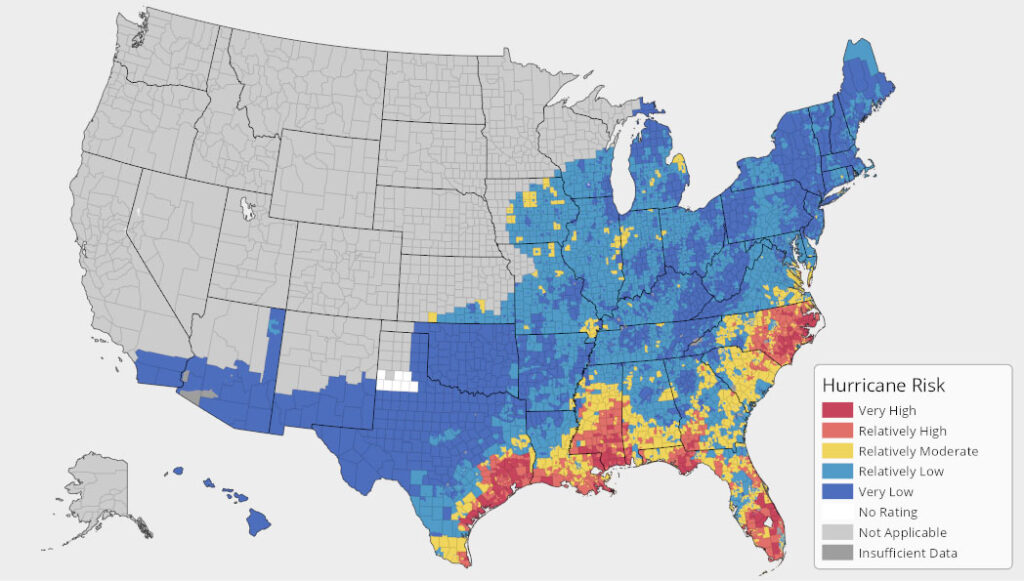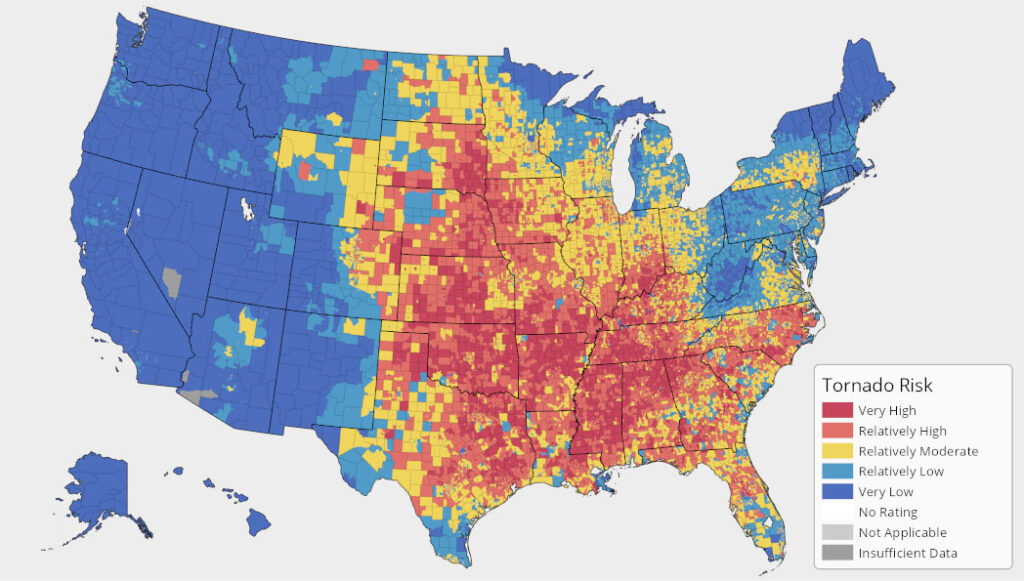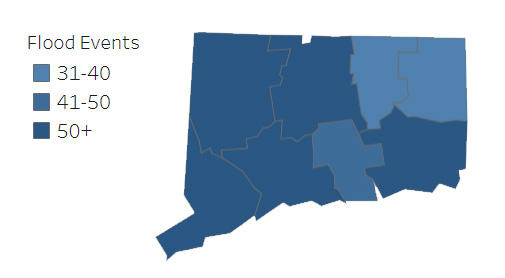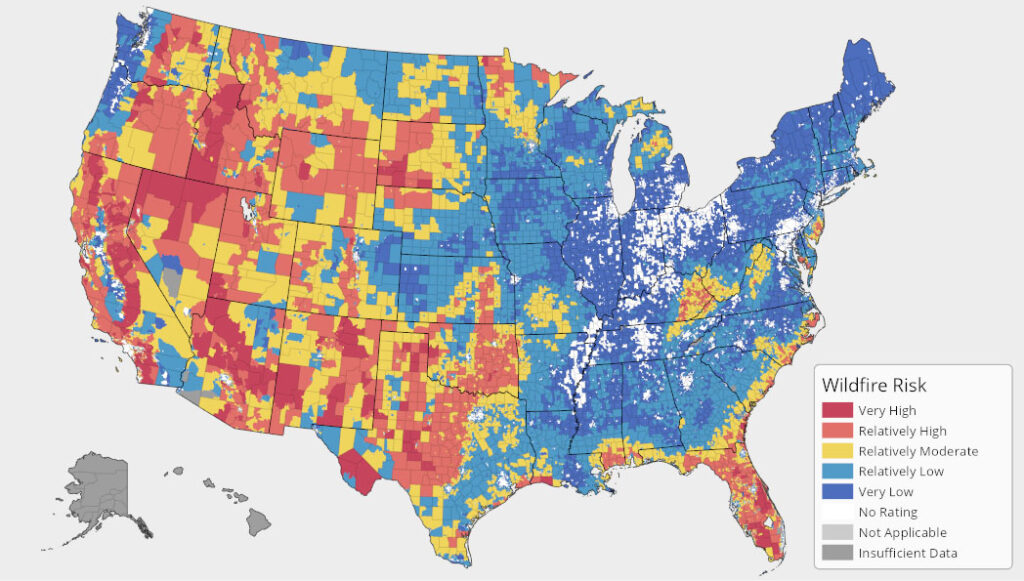Over 3.6 million people live in Connecticut. Many of these people have experienced natural disasters in the state firsthand. However, many don’t realize just how many different natural disasters can occur in the state or how the risk for some disasters is increasing.
Here we will go over what natural disasters occur in Connecticut, the worst natural disasters to hit the state since 2000, and what can be done to prepare.
Is Connecticut At Risk of Natural Disasters?
Compared to the rest of the country, Connecticut has a very low risk of natural disasters. There have been 24 disaster declarations in Connecticut since 2000. Of these, 13 were Major Disaster Declarations. There were 14 disaster events affecting Connecticut, which caused more than $1 billion in damages.
Since 2000, Connecticut has had the following:
- 24 disaster declarations
- 13 Major Disaster Declarations
- 14 events that caused $1 billion or more in damages
Worst Natural Disasters in Connecticut Since 2000
Since 2000, all of the worst natural disasters in Connecticut have been hurricanes. The costliest and deadliest ones were hurricanes Sandy, Ida, and Irene.
Worst Natural Disasters in Connecticut By Cost (Since 2000)
- Hurricane Sandy 2012: $81.9 billion
- Hurricane Ida 2021: $78.7 billion
- Hurricane Irene 2011: $17.4 billion
- Hurricane Isaias 2020: $5.3 billion
- 2016 Drought: $4.2 billion
Worst Natural Disasters in Connecticut By Deaths (Since 2000)
- Hurricane Sandy 2012: 159 deaths
- Hurricane Ida 2021: 96 deaths
- Hurricane Irene 2011: 45 deaths
- Groundhog Day blizzard 2011: 36 deaths
- 2020 Easter tornado outbreak: 35 deaths
*Cost and death tolls are for the entire disaster, including in other states affected.
What Natural Disasters Occur in Connecticut?
1. Hurricanes/Tropical Storms
Since 2000, Connecticut has declared disaster 5 times because of hurricanes. These were for hurricanes: Ida, Henri, Isaias, Sandy, and Irene.
While hurricanes aren’t generally as destructive in Connecticut as in southern coastal states, they can still take a toll. During hurricane Sandy in CT, four people died in the state. Irene caused 11 deaths in Connecticut. These hurricanes left hundreds of thousands of people without power and caused millions in damages.
For more, read: Hurricane Survive Tips

2. Tornadoes
Connecticut isn’t associated with tornadoes, but they do occur in the state. Since 2000, there have been 20 tornado events that were F1 or stronger. While none of these tornadoes caused any deaths, and there were only 4 injuries, some did cause large amounts of property damage.
The worst tornado in Connecticut during this period was the July 2013 tornado which hit East Windsor, Windsor Locks, and Fairfield County. It caused approximately $5 million in damages.
To be prepared for a tornado, Connecticut residents should make sure they know what to do during a tornado, have a tornado storm shelter or designated safe room, and be ready for power outages.

3. Winter Storms and Freeze Events
Connecticut has had severe winter weather, snowstorms, and freeze events yearly for the past several decades. Five of these were bad enough to merit a disaster declaration.
These severe winter weather events can cause serious problems for residents. Power outages are common when power lines become overloaded with snow or damaged by falling branches or wind.
During the Halloween Nor’easter in 2011, there were 830,000 power outages in Connecticut alone. Some people didn’t get their power back for 11 days. There were 10 deaths in the state during this snowstorm.
It is also common for auto accidents to occur during snowstorms in Connecticut. One of the worst was during the 2009 snowstorm. In addition to the 157 vehicle accidents, there were over 1,100 calls for service from people who had spin-outs, got their vehicles stuck in the snow, ran out of gas, or other problems.
This shows how important it is for drivers in Connecticut to have a winter vehicle emergency kit and basic supplies like an indoor emergency heater in case they become stranded.
4. Floods
As a coastal state, Connecticut is at high risk for flooding. From 2005 to 2014, the state averaged 18 coastal flooding days. Due to global warming, the risk of flooding – including severe flooding of 6 feet or more – is increasing.
In addition to coastal flooding, many parts of Connecticut are at-risk for river and widespread flooding. One study found that over 106,000 properties in Connecticut were at risk of flooding in 20202. By 2050, this number will have increased to 117,000 properties. Since 2000, there have been over 45,200 flood insurance claims through FEMA in Connecticut.

The areas in Connecticut at most risk of flooding are:
- Old Greenwich
- Cos Cob
- Branford Center
- East Haven
- Westport
- Darien
- Norwalk
- Bridgeport
- Greenwich
- Hartford
Worst Floods in Recent Connecticut History
Connecticut has had numerous flood events since 2000. One of the worst flood events was after Hurricane Irene in 2011, during which 8,000 properties were flooded. The 2009 Nor’ester flooded over 2,100 properties in the state and left 110,000 people without power.
Heavy rains during the March 2010 floods caused the Pawtuxet River to crest 20 feet and the Yantic River 13.6 feet. Hundreds of properties were flooded, parts of highways and Amtrak were closed, and upwards of 25,000 people were left without power.
In addition to these massive flood events, Connecticut regularly sees smaller, more localized flood events. Nowhere in the state is completely safe from flooding, so all residents must be prepared.
5. Wildfires
Compared to the rest of the United States, Connecticut has a very low risk of wildfires. However, that doesn’t mean wildfires don’t occur. On average, wildfires burn 500 acres per year in Connecticut. During times of drought, the risk of wildfires can be very high.
In addition to wildfires, Connecticut sometimes has fires in mulch beds or grassy areas. These are caused mainly by people throwing cigarettes on the ground.
So, even though the risk is low, Connecticut residents should still follow fire prevention advice, such as clearing dead debris from their yards. It’s also important to know what to do during a wildfire, have a Go Bag ready, and keep valuables in a fireproof safe.

6. Heat Waves
Currently, Connecticut only has a moderate risk of heat waves, and the state has never had to declare a disaster because of extreme heat. However, Connecticut is the fastest-warming state in the contiguous USA.
Since the 19th century, the average temperature in Connecticut has risen by 3.5F. This is twice the average of the other 48 lower states. As a result, heat waves will become common in Connecticut. All of the top 10 highest temperatures in the state’s history occurred since 1990, and 5 have occurred since 2010.
By 2050, it’s estimated that Connecticut will have an average of 44 days with temperatures over 90 degrees. For this reason, Connecticut residents need to be prepared for heat waves and the problems that can occur, such as power outages.
For more, read: How to Survive Extreme Heat

7. Drought
Drought is widespread in Connecticut, and drought risk is only increasing.
Because agriculture only makes up a small portion of Connecticut’s economy, the effects of droughts aren’t as significant as in many other US states.
However, drought still hurts Connecticut’s farmers, which in turn can cause increased prices for consumers. In some areas of CT, mandatory water conservation measures have been implemented.
Increased drought also increases the risk of wildfires in Connecticut. Burn scars from wildfires, then increase the risk of flash flooding.
https://www.ncei.noaa.gov/access/billions/events/CT/2000-2022?disasters[]=all-disasters
https://www.ctinsider.com/news/article/climate-change-ct-heat-wave-17323388.php
https://statesummaries.ncics.org/chapter/ct/
https://www.courant.com/breaking-news/hc-br-deep-wildfire-extreme-warning-connecticut-20220812-pyiibdpokngaxh7qssz5buzxya-story.html
https://universitysafety.uconn.edu/fire/safety/
https://www.fema.gov/data-visualization/historical-flood-risk-and-costs
https://circa.uconn.edu/sea-level-rise-and-storm-surge-viewer/
https://portal.ct.gov/DESPP/Press-Releases/2009/Troopers-Report-on-First-Winter-Storm
https://www.nbcconnecticut.com/news/local/tornado-warning-in-effect-for-fairfield-county/1929819/
https://www.nbcconnecticut.com/weather-news/stories/hurricane-sandy-10-years-later/2895856/
https://nesec.org/hurricanes/
https://www.ncdc.noaa.gov/stormevents/
https://www.middletownpress.com/news/article/Everything-got-set-back-Drought-hurts-New-17421800.php
https://www.ncei.noaa.gov/access/billions/events/AR/2000-2022?disasters[]=all-disasters


